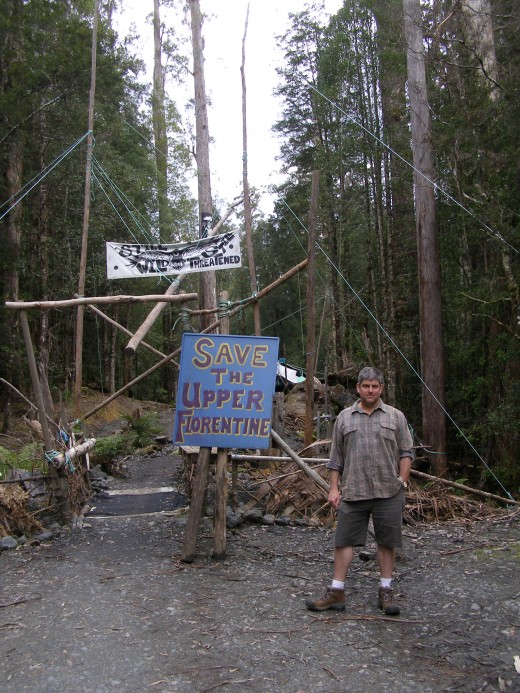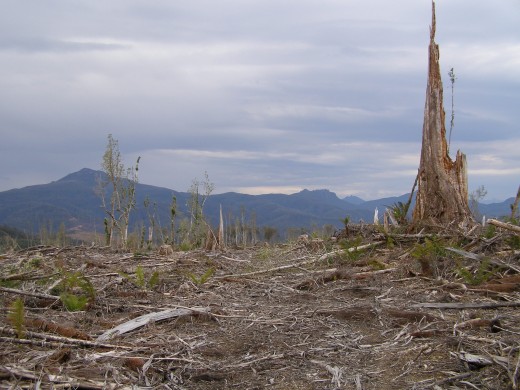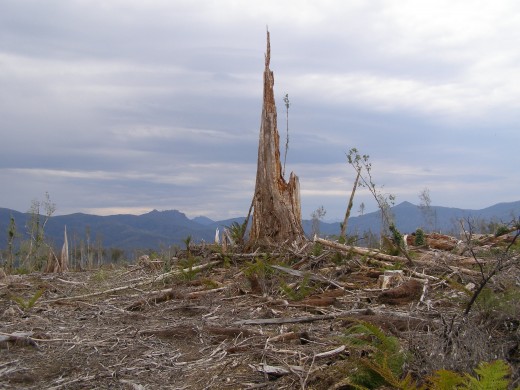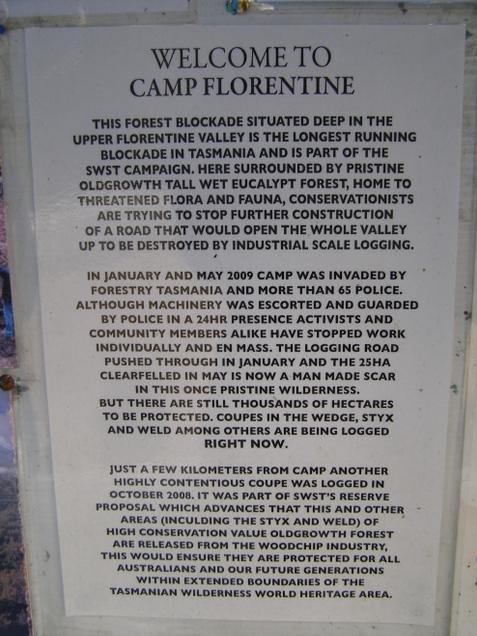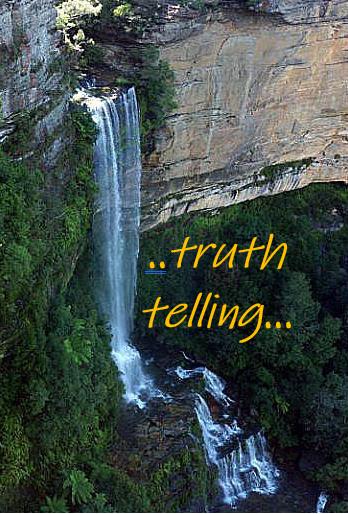Archive for the ‘Habitat Threats’ Category
Friday, October 21st, 2011
 Stihl Concrete Saw Stihl Concrete Saw
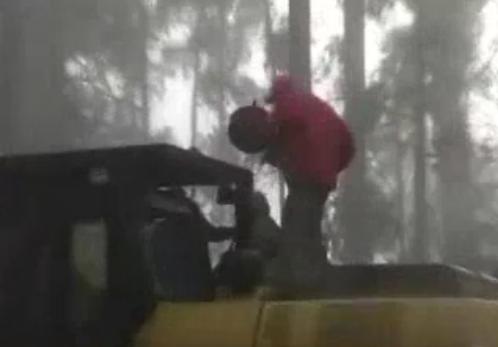 Stihl Saw Nutter – contracted with Forestry Tasmania, October 2008 Stihl Saw Nutter – contracted with Forestry Tasmania, October 2008
(Click photo above to play video in YouTube, turn up your PC volume)
.
 Stihl President – Fred Whyte
(Billings Gazette) Stihl President – Fred Whyte
(Billings Gazette)
.
In September 2010, Fred J. Whyte, president of STIHL Inc., was elected chairman of the Outdoor Power Equipment Institute (OPEI) during the association’s 58th annual meeting in Coeur D’Alene, Idaho.
.
“I am honored to again represent STIHL and the outdoor power equipment industry as chairman of the OPEI board,” said Whyte.
“In this next year, we hope to accomplish a lot, especially in the realm of educating the public on the safe and efficient use of outdoor power equipment. We are seeing gains in the market, which should be welcome news to all OPEI members. Let’s hope we return to our market prosperity with new sustainable programs and products that will lead us into the next generation.”
.
[Source: Stihl USA, ^http://www.stihlusa.com/pressrelease/september10_FJWOPEI_corporate.aspx]
.
.
Two years prior (2006) …’Defending Tasmania’s ancient forest’
.
[Source: Tasmanian Times, 20061106, ^http://tasmaniantimes.com/index.php?/article/defending-tasmanias-ancient-forest/ ]
.
‘This week has marked a new chapter in the defence of Tasmania’s ancient forests with 17 arrests in the Weld Valley, Southern Tasmania.The arrests occured whilst community members were trying to prevent an access road that will allow the chainsaws into majestic ancient forests.The Weld Valley has now become one of the largest resistance campaigns for Tasmania’s forests in the last decade. Community outrage at this senseless devastation is challenging the Tasmanian and Australian governments to give these wilderness forests the protection they deserve.
For more than a year, forest defenders built and lived in a beautiful conservation haven that worked to hold the chainsaws and bulldozers at bay. Camp Weld, had a full size replica Pirate ship (the Weld Ark), a bush cabin and the entire infrastructure needed to provide shelter and support to friends of the forest. The camp had a village style atmosphere and was open to all comers who wanted to help the forests in their plight. Camp Weld members faced not only the hostility of the weather, the driving rain, winter dark and snow but also the very real hostility and threats from logging industry supporters.
.
‘Through the year, Camp Weld faced gun shots, car burnings and physical threats from loggers coming directly into camp.’
.
All this was greeted with the strength and commitment of non-violent action and this peaceful response is a testament to the bravery and beauty of the people who lived there.
On Wed 15th November 2006, more than 60 Police raided the camp with one immediate arrest and a lone tree-sitter escaping to her lofty perch.Everyone else was ordered to leave or face arrest under a new media and public exclusion zone placed around a 10 kilometre radius of this state owned forest. For the next 6 days a set of rolling actions began and continue, flowing from the anger at the loss of such a direct action icon and the coming loss of these wondrous forests. People climbed tree-sits, stood in front of machines and some forest defenders locked theselves on to machinery. These actions occurred day after day as the arrest tally climbed to the present 17.
.
For 5 days, the lone tree sitter ‘Pixie’ sat in her high platform watching the events unfold..
Two other forest defenders spent nights in jail as Police used legal tactics to try and prevent the arrestees from returning to the forests. The Tasmanian government has funded this operation to secure access for Gunns Ltd, providing large numbers of police, security, a 24 hour mobile operations base and satellite communications equipment, all to ensure that the bulldozers get into the forest. Yet despite these obstacles people continue to challenge the destruction in a peaceful and defiant manner.
.
Classic non-violent style
.
On two separate occasions, a community walk in was staged to defy the archaic exclusion zone created on public land. The first walk in had 40 people, the second over 100. These were great days for the forests as smiling people walked past security and police, in classic non-violent style. The strength in numbers meant that the police were unable to implement the exclusion zone procedures, which involves individually approaching each person in the zone. The veil over this hideous environmental crime had been lifted.This type of protest has occurred because of the continued failure of the Regional Forest Agreement (RFA) and the subsequent Community Forest Agreement, which were set up under the pretence to solve the forest debate in Tasmania. In fact, things in the forest have gotten worse, roads continue to be cut into high conservation value forests and logging is planned for many high conservation value forests and wilderness areas across the state. A downturn in the woodchip market has not deterred the world largest hardwood woodchipper, Gunns Ltd from continuing their devastation of the island’s wildlife and trees. Their aggressive response to criticism is to sue conservationists and environmental groups with a blanket multi-million dollar civil case.This almost billion dollar company and its $65million man, John Gay, have a strangle hold on the states politicians and its old growth forests.
The Weld Valley is a shining example of places ignored by the chainsaw mandate of the RFA; it is an ancient forested valley of towering trees, moss filled rainforest gullies, snow-capped mountains, wide plains, crystal clear streams and wild Weld river. The original Tasmanians wandered this valley some 20,000 years ago evidence of their lives still remain in the national park protected ‘Bone Cave’ in the upper Weld. The potential for more sites or caves remains unexplored in much of the logging slated lower Weld Valley. While some 80% is protected in the South West World Heritage Area, the remaining forests suffer a very different fate to those separated by the imaginary protection line.
These remaining forests of the lower Weld Valley have been recognized by local and international environmental groups, the United Nations and even Tasmania’s Parks and Wildlife as having equal conservation status to the rest of the valley. Viewed as a single wilderness area, the Weld Valley is a unique landform which has a rare combination of outstanding biological, geological and cultural features naturally linked by continuous forest to the World Heritage Area.
Direct action has always been an area of last resort for conservationist. Brave and often reluctant heroes staff this front line with sometimes little more than their own bodies. Placing lives on hold and committing all for the forests. Basing actions on non-violent principles, that has served people and social movements like Gandhi, the Suffragettes, the Civil Rights struggle and our own Franklin River campaign. As long as companies like Gunns Ltd are allowed, by governments, to ignore community concern and run rampant through our ancient forests with chainsaws and bulldozers then there will always be people willing to stand in their defence.’
.
[Adam Burling is a founding member of the Huon Valley Environment Centre, a part time advisor to Senator Bob Brown and a Gunns 20 defendant.]
.
Tags: activists, Camp Weld, Caterpillar, Community Forest Agreement, Direct action, forester violence, Forestry Tasmania, Fred Whyte, Logging, Martin Bryant, old growth forest, Outdoor Power Equipment Institute, stihl chainsawing old-growth, STIHL Inc., Stihl President, Stihl Saw, Stihl Saw Nutter, Stihl woodchipping old growth, Tasmanian Police, Weld Valley, William Adams, World Heritage Area, www.stihlusa.com
Posted in Tasmania (AU), Threats from Deforestation, Threats to Wild Tasmania | No Comments »
Add this post to Del.icio.us - Digg
Thursday, October 13th, 2011
If you go down into the woods today you’re sure in for a big surprise…but in Tasmania’s South-West it ain’t no teddy bear’s picnic.
One has to first get past the many infamous locked gates. Forestry Tasmania (aka the State-sanctioned corporate logger) is sure to have locked its steel gates for very good reason – Forestry Tasmania doesn’t want the public to know the truth about what it is doing to Tasmania’s remaining wild forests.
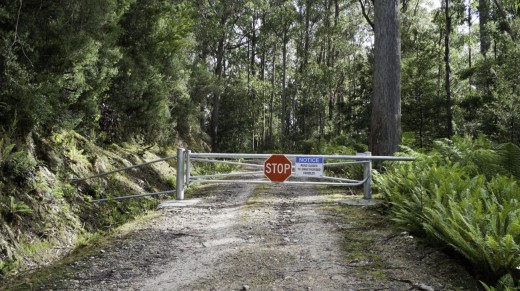 Forestry Tasmania’s locked gate on the public road to the top of Mount Tim Shea
(Suspiciously this public access road was deemed unfit for public travel coincidentally around the same time as Forestry Tasmania opened its ‘Adventure Hub’ in Maydena,
and equally coincidentally one of the hills they charge people for a ride to the top from reads ‘Adventure Hub’).
(Photo by Alan Lesheim) Forestry Tasmania’s locked gate on the public road to the top of Mount Tim Shea
(Suspiciously this public access road was deemed unfit for public travel coincidentally around the same time as Forestry Tasmania opened its ‘Adventure Hub’ in Maydena,
and equally coincidentally one of the hills they charge people for a ride to the top from reads ‘Adventure Hub’).
(Photo by Alan Lesheim)
.
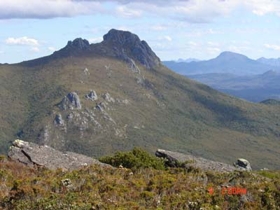 Rugged Mount Tim Shea, South-West Tasmania Rugged Mount Tim Shea, South-West Tasmania
Photo by Forestry Tasmania
^http://www.forestrytas.com.au/topics/2008/06/maydena-adventure-hub-opportunities
.
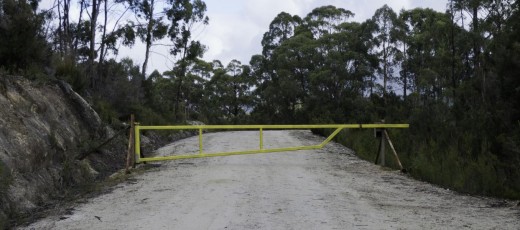 Locked Gate on Five Road in the Upper Florentine Locked Gate on Five Road in the Upper Florentine
(connects to Cook’s Track which enters the Gordon River Road short of Camp Flozza)
(Photo by Alan Lesheim)
.
Forestry Tasmania has hundreds of these padlocked gates throughout Tasmania’s wild forests.
The Wilderness Society’s spokesperson Amanda Sully said “Forestry Tasmania have a locked boom gate over the Huon Valley Wilderness and are refusing entry. This is just one of hundreds of gates on forestry roads in Tasmania.
“It’s very clear who is locking up the forests. People are sick and tired of seeing log truck after log truck coming from the clear felling behind these padlocked gates.
These are publicly-owned forests.
Forestry Tasmania is supposed to manage them for the benefit of all Tasmanians, not just the loggers” Ms Sully concluded.
.
[Source: ‘Forestry Tasmania – Locking up our forests‘, ^http://www.wilderness.org.au/campaigns/forests/19980924_mr
.
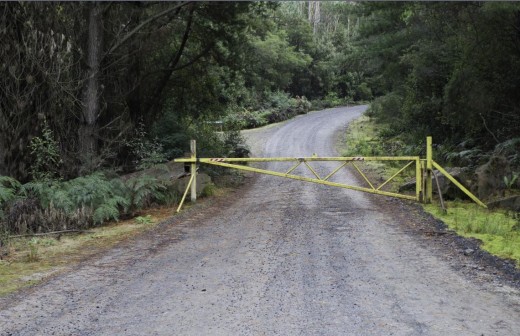 Forestry Locked Gate on Blue Road, northern section of the Upper Florentine Valley Forestry Locked Gate on Blue Road, northern section of the Upper Florentine Valley
(Photo by Alan Lesheim)
.
.
Author Anna Krien was on a quest for the truth described in her revealing expose book of 2010 into what’s stihl happening in Tasmania’s wild forests:
~
‘Most people travelling through Tasmania will never know of the long-running hide-and-seek taking place in the labyrinth of logging roads beyond the bitumen.
Sightseers walk among 300-year-old trees, some of them 90 metres tall, in the Styx Big Tree Reserve, chainsaws can be heard in the distance.
The road into this attraction is lined with stage sets of wilderness.
At the rise of a hill, just before the nose of the car tilts downwards, passengers might glimpse a balding peak, a fleeting insight into the world behind the verge.’
~
[Source: ‘Into the Woods: The Battle for Tasmania’s Forests‘, 2010 by Anna Krien pp.25-26, published by Black Inc. ^http://www.blackincbooks.com/books/woods, includes video interviews].
.
So, this Editor, half way through the book, last month flew down to Hobart, hired a car and retraced the author’s journey into Tasmania’s South-West …
.
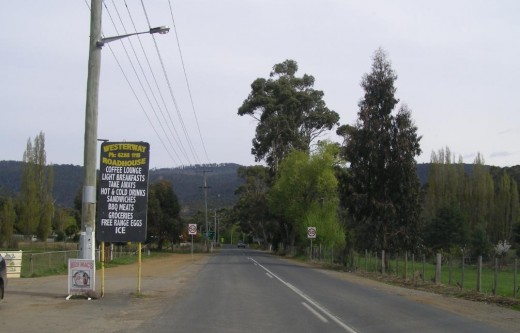 Driving west along the old Hydro Electrical Commission’s (HEC) Gordon River (Access) Road,
through Forestry’s logging town of ‘Westerway’ Driving west along the old Hydro Electrical Commission’s (HEC) Gordon River (Access) Road,
through Forestry’s logging town of ‘Westerway’
.
Noticeably, when driving out of Hobart I passed clearly wealthy residential suburbs, yet driving along the Gordon River Road these few isolated hamlets are not wealthy. Their construction mostly seems temporary like mining companies would construct while the mine delivers. The highway through the hamlets of Westerway, Fitzgerald and Maydena seems only for forest access, not for community.
I parked the car and walked through Maydena.
There is only the odd person out and about. The place seems impoverished – one small primary school, a notable lack of shops, lack of amenities, and little sign of any vibrant community.
It’s as if the profits from logging have driven right through the guts of these local villages and on to big corporations eastward.
.
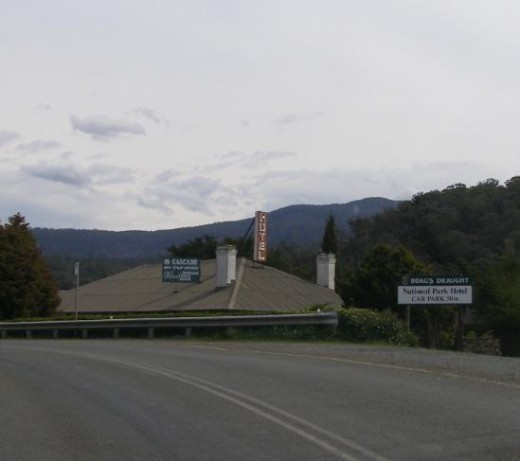 Past the National Park Hotel
where Tasmania’s champion wood-chopper ‘Big Dave’ holds pride of place above the pub’s fire place. Past the National Park Hotel
where Tasmania’s champion wood-chopper ‘Big Dave’ holds pride of place above the pub’s fire place.
.
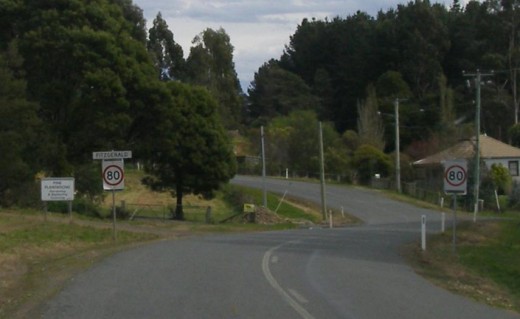 Driving through Forestry’s old logging town of ‘Fitzgerald’
. Driving through Forestry’s old logging town of ‘Fitzgerald’
.
.
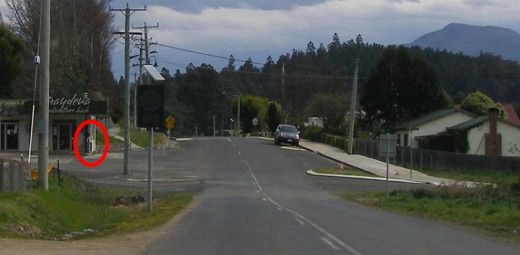 Driving through the old logging town of ‘Maydena’
– a closed so-called ‘Adventure Hub’ on the left, yet its diesel bowser (circled) open for Forestry Tasmania vehicles and observed in used by Editor 20110928. Driving through the old logging town of ‘Maydena’
– a closed so-called ‘Adventure Hub’ on the left, yet its diesel bowser (circled) open for Forestry Tasmania vehicles and observed in used by Editor 20110928.
.
Reminiscent of Australia’s 1850s Gold Rush, Tasmanian folk would have been lured west by Forestry to the promise of bountiful tall timber delivering reliable logging income and the promise of building personal wealth.
But along the Gordon River Road there is a stark absence of Forestry wealth. Instead it seems Forestry has abandoned these Gordon River Road communities.
What Forestry has done is to sell out Tasmania’s traditional woodcraft industry for short term profit from flogging quality Tasmanian hardwood as cheap asian woodchips, destroying Tasmania’s forests timber communities in the process. Then Gunns got greedy and Tasmania’s timber reputation has deteriorated thereafter.
Now Forestry Tasmania are clearfelling and selling out Tasmania’s rare forests to the asians direct, to the likes of Ta Ann. Forestry Tasmania is no more than a corporate pimp of Tasmanian rare forest heritage.
.
“The road into this attraction is lined with stage sets of wilderness.”
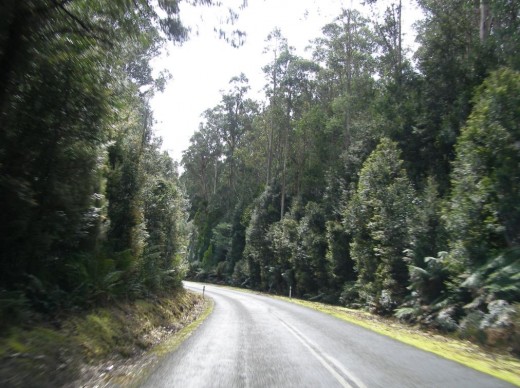 Driving further west along the HEC Gordon River Road
– bulldozed in 1964 through 64km of pristine wilderness forest by the Hydro Electric Commission, and
funded by the then Menzies federal government at a cost of £2.5 million (likely twenty times that in today’s terms – i.e. $50 million.
. Driving further west along the HEC Gordon River Road
– bulldozed in 1964 through 64km of pristine wilderness forest by the Hydro Electric Commission, and
funded by the then Menzies federal government at a cost of £2.5 million (likely twenty times that in today’s terms – i.e. $50 million.
.
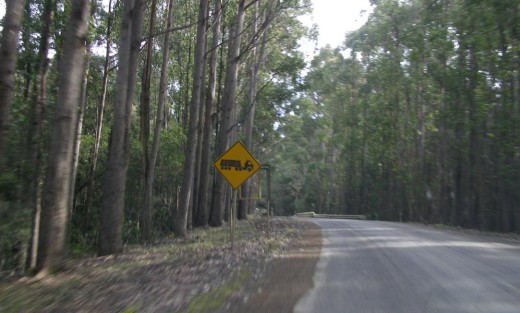 Gordon River Road – signposted logging country Gordon River Road – signposted logging country
.
“At the rise of a hill, just before the nose of the car tilts downwards, passengers might glimpse a balding peak”
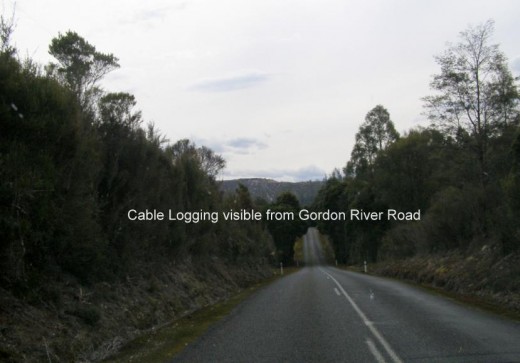 The balding peak of Forestry Tasmania’s cable logging…’a fleeting insight into the world behind the verge’.
(Photo by editor 20110928 while on Gordon River Road heading west) The balding peak of Forestry Tasmania’s cable logging…’a fleeting insight into the world behind the verge’.
(Photo by editor 20110928 while on Gordon River Road heading west)
.
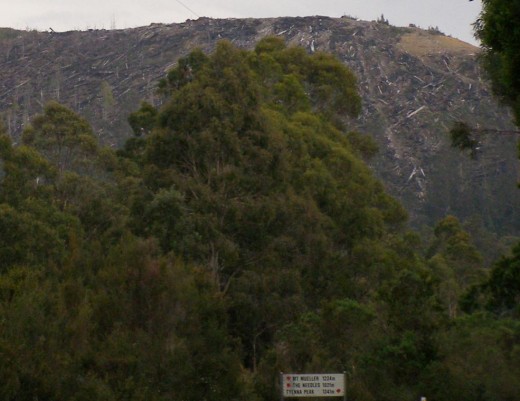 An entire hill of wild Tasmanian forest savagely cabled logged bare by Forestry Tasmania
Tourists can now see this from Gordon River Road.
(Photo by editor 20110928. Click photo to enlarge.)
An entire hill of wild Tasmanian forest savagely cabled logged bare by Forestry Tasmania
Tourists can now see this from Gordon River Road.
(Photo by editor 20110928. Click photo to enlarge.)
.
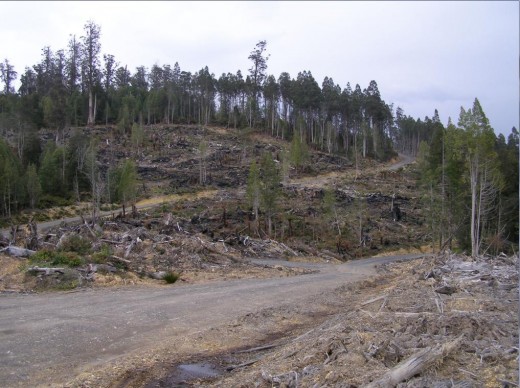 Beyond the lock gates lies the ecological holocaust
(Photo by editor 20110928. Click photo to enlarge.) Beyond the lock gates lies the ecological holocaust
(Photo by editor 20110928. Click photo to enlarge.)
.
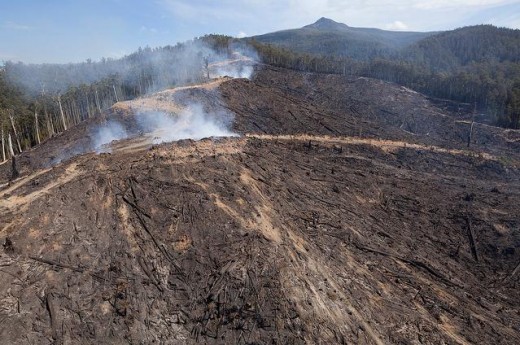 Styx Valley Holocaust
(Photo by Rob Blakers) Styx Valley Holocaust
(Photo by Rob Blakers)
.
 Tasmania’ s Styx Holocaust
September 2011 (Photo by Alan Lesheim)
Tasmania’ s Styx Holocaust
September 2011 (Photo by Alan Lesheim)
.
 Forestry Tasmania’s Killing Fields
Forestry Tasmania’s Killing Fields
.
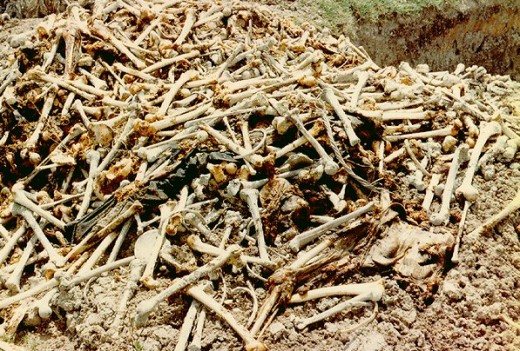 Cambodia’s Khmer Rouge Killing Fields
(Human mass murder comparable to Tasmania’s mass forest murder
– both crimes consistently against life) Cambodia’s Khmer Rouge Killing Fields
(Human mass murder comparable to Tasmania’s mass forest murder
– both crimes consistently against life)
.
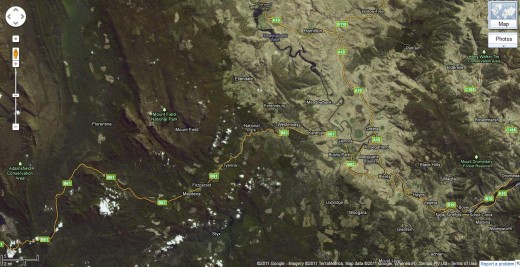 Google Maps (September 2011) satellite view of the forest rape by Forestry Tasmania
.
Google Maps (September 2011) satellite view of the forest rape by Forestry Tasmania
.
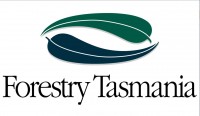 . .
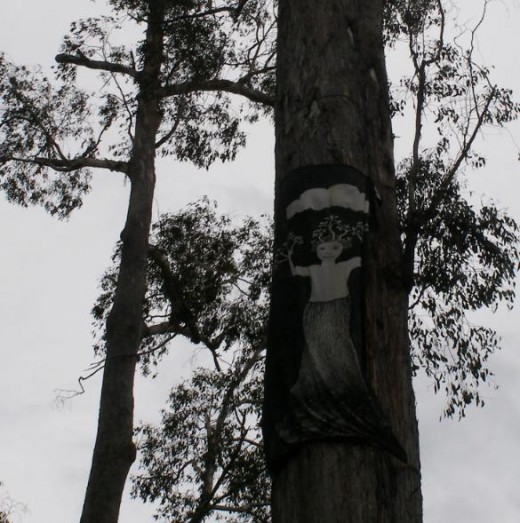 Camp Flozza’s symbolic goddess of the ancient Florentine Forest
~ eco-raped by Forestry Tasmania in its January 2009 raid
Camp Flozza’s symbolic goddess of the ancient Florentine Forest
~ eco-raped by Forestry Tasmania in its January 2009 raid
.
 And they wonder why the people protest and are prepared to be arrested?
(Photo of forest defender being arrested at Forestry Tasmania’s police raid on Camp Flozza,
Upper Florentine Valley, 13th January 2009) And they wonder why the people protest and are prepared to be arrested?
(Photo of forest defender being arrested at Forestry Tasmania’s police raid on Camp Flozza,
Upper Florentine Valley, 13th January 2009)
.
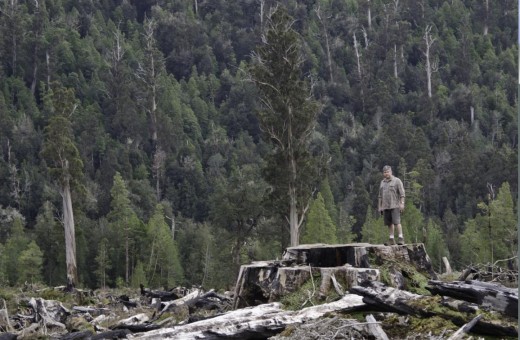 Styx Valley Holocaust by Forestry Tasmania, September 2011
(Photo of editor 20110928. Click photo to enlarge.)
Styx Valley Holocaust by Forestry Tasmania, September 2011
(Photo of editor 20110928. Click photo to enlarge.)
.
.
Forestry Tasmania padlocks gates 10 kilometres from clearfell around a protected Wedge-tailed Eagle nest
[Source: ‘Loggers breach eagle nest protection laws again‘, Bob Brown, 20090827, ^http://bob-brown.greensmps.org.au/category/issues/environment/forestry/wielangta]
‘In the breeding season, a clear felling operation in Tasmania’s wild Upper Huon Valley has breached guidelines by smashing down forests next to an endangered Tasmania’s Wedge-tailed eagles’ nest. The Tasmanian Wedge-tailed eagle, with wingspan up to 3 metres, are one of the Earth’s 6 largest eagle species.
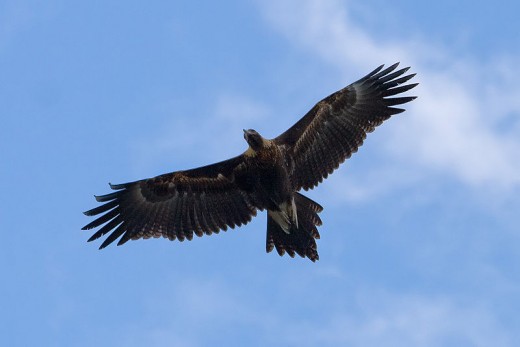
“After repeated controversies about woodchip operations burning or destroying eagle nests and causing failure of nesting because of bulldozers and chainsaws operations near nests, this failure of protection in the Huon is inexcusable. It makes a mockery of logging industry propaganda,” said Australian Greens Leader Bob Brown.
“The Ministers for Forestry and Environment who are responsible for Australia’s rare and endangered species don’t know, and don’t act in any helpful way.”
“It is as if the Howard Government never left office. These ministers have washed their hands of their role in the Wedge-tailed eagles’ fate. Logging laws in Tasmania state that a minimum of 10 hectares be left around an eagle’s nest,” said Senator Brown.
Forestry Tasmania has erected locked gates 10 kilometres from the nest logging site preventing public or media inspection.’
.
Footage of the logged area and nest available here (on YouTube):

.
.
Meanwhile Forestry Tasmania on its ‘Adventure Forests‘ website promotes its ‘Top of the World Tour‘ from Maydena…

…’Go wild where eagles soar…Make the escape to the Eagle’s Eyrie on a Top of the World Tour.You’ll experience all the fun of the Railtrack Rider as you travel into the heart of the forest to explore long-abandoned bush heritage, before emerging to an alpine wonderland and an eagle’s eye view over the Tasmanian wilderness. There’s plenty of time for indulgence as well, with an individually-prepared gourmet lunchbox and fine regional wines enjoyed in the fireside comfort of the Eagles Eyrie.’
^http://adventureforests.com.au/maydena
.
.
‘The real voyage of discovery consists not in seeking new landscapes
but having new eyes’
~ Marcel Proust, French novelist
Tags: Anna Krien, Cable Logging, Camp Flozza, deforestation, Fitzgerald, Florentine Valley Holocaust, Forestry Holocaust, Forestry Locked Gates, Forestry Tasmania, Gordon River Road, having new eyes, Into the Woods, Maydena, Maydena Adventure Hub, Mount Tim Shea, National Park hotel, Styx Big Tree Reserve, Styx Forest, Styx Valley, Styx Valley Holocaust, Ta Ann, Tasmania, Tasmania's Ancient Forests, Tasmania's South West, Tasmania's Wild Forests, Upper Florentine Forest, Wedge-tailed Eagle, Westerway, wild forests
Posted in Eagles, Tasmania (AU), Threats from Deforestation, Threats to Wild Tasmania | No Comments »
Add this post to Del.icio.us - Digg
Monday, October 10th, 2011
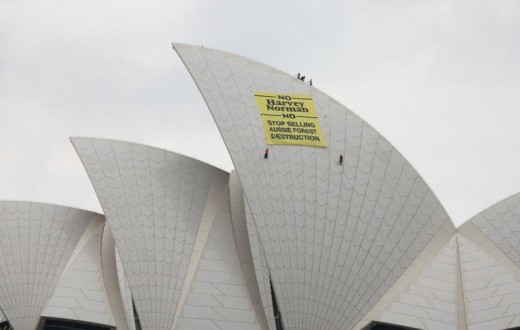 Last Saturday, forest activists scaled Sydney’s Opera House and unfurled a huge banner reading: Last Saturday, forest activists scaled Sydney’s Opera House and unfurled a huge banner reading:
‘No Harvey No! Stop selling Aussie forest destruction’!
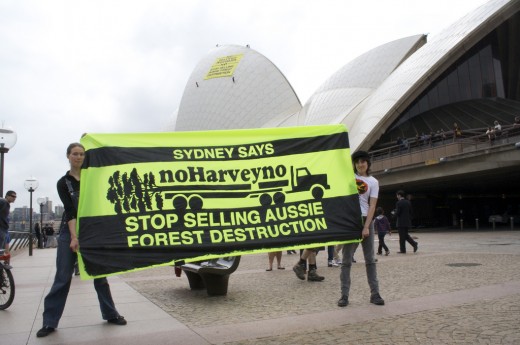
“We have come to the centre of Sydney to send a clear message to Harvey Norman that profiting from the destruction of our spectacular forests is absolutely unacceptable’ said Ula Majewski, spokesperson for The Last Stand.”
‘Our internationally iconic Aussie forests are still being destroyed by industrial logging operations. We are taking peaceful action from the top of another great Aussie icon to tell Harvey Norman that selling Aussie forest destruction is no way to do business’ said Miranda Gibson, currently perched atop the Opera House..
~ The Last Stand Inc.
^http://www.thelaststand.org.au
[Source: ^http://tasmaniantimes.com/index.php?/weblog/article/forest-activists-scale-the-sydney-opera-house/]
.
 
.
Why do forest activists scale the Sydney Opera House to protest their message?

They personally risk their lives, are arrested, put in gaol; and in these days of corporate background checks, are denied corporate employment for the rest of their lives.
How many of our readers realise the seriousness of these young people and their moral custodial commitment to fighting for the protestion of Australia’s remaining and irreplaceable ancient forest ecosystems? Australia’s youth represent and prepared to be incarcerated to protect Australia’s natural heritage. These protesters in generations to come, when the economic bigotry has died, will be venerated as Australian diggers defending what is uniquely Australian.
While the mainstream media are more interested in a commercial football match in Auckland that comes around and goes around, the vicious industrial lumberjacks in Forestry Tasmania, Forestry Victoria, and Forestry New South Wales (or whatever their rebranded name) are daily decimating vast hectares of Australia’s wild native forests. This State-sanctioned ecological massacre of old growth forests is the core reason why Australia has been internationally degraded with a backward reputation for recording the highest rates of wildlife extinction in the 21st Century. Australia is down their in ecological degradation with Zimbabwe, Rwanda and Mozambique.
Why do forest activists scale the Sydney Opera House to protest their message?
Well, start to appreciate the grassroots struggle that has for years been unreported by the mainstream media…
.
‘Conservationist halt roading operations in the iconic Styx valley’
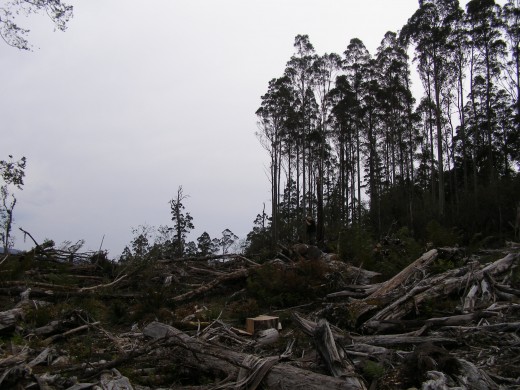
Tasmania’s ancient Styx Forest slaughtered for Malaysian woodchips,
continuing to be subject to Forestry Tasmania holocaust
– utter clearfell followed by blanketed incineration so that the old forest is obliterated forever
– just like what the Nazi’s did to the Jews – out of sight out of mind, until the war was over.
(Photo by editor 20110928, free in public domain, click to enlarge and then click to enlarge again)
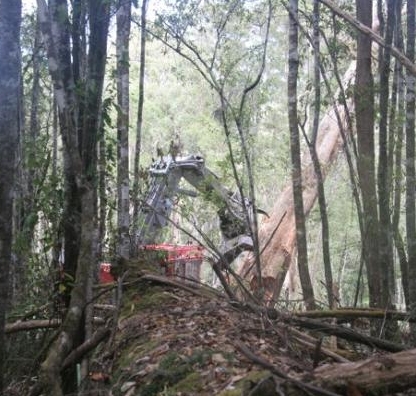
‘Today twelve conservationists have halted a new roading operation in the Styx Valley as part of a ten week campaign to highlight the urgent need for Tasmania’s high conservation value forests to be protected. The recently started roading operation leads to Coupe SX038D and is within a high conservation value area proposed for formal reserve. One protester is in a tree sit, which is attached to roading machinery, preventing any operations from continuing for the day.
.
“The fact that a new road is currently being pushed into high conservation value forest in a area that should have been under moratorium weeks ago, is a clear indication that Forestry Tasmania are not taking appropriate action to reschedule coupes and implement the moratorium” said Miranda Gibson, spokesperson from Still Wild Still Threatened.
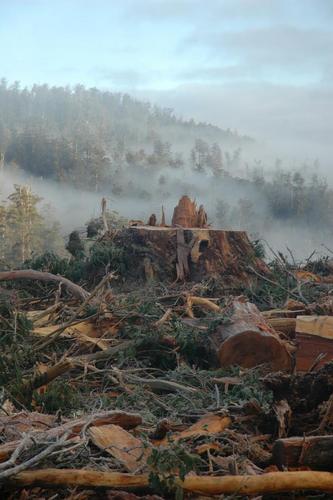
“How can the Tasmanian community have faith in Forestry Tasmania when they have not only failed to meet the moratorium deadline, but are now blatantly disregarding government directive to reschedule coupes? If Forestry Tasmania were serious about implementing the moratorium, they certainly would not be wasting taxpayers money investing in brand new roads to access iconic forests that have been earmarked for protection.” said Ms Gibson.’
.
[Source: Still Wild Still Threatened, 20110412, ^http://www.stillwildstillthreatened.org/main-categories/current-news]
.
 Maranda Gibson, defender of Tasmania’s forest heritage Maranda Gibson, defender of Tasmania’s forest heritage
One of the arrested protesters on the Opera House last Saturday
.
 . .
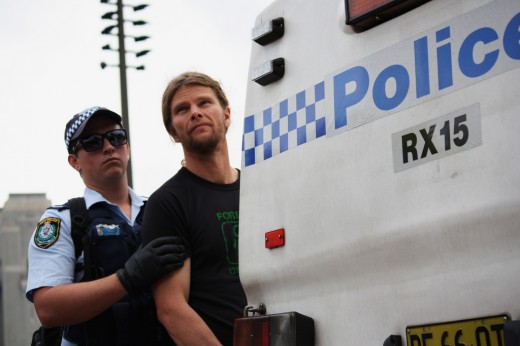 Prepared to be arrested for Tasmanian principle Prepared to be arrested for Tasmanian principle
.
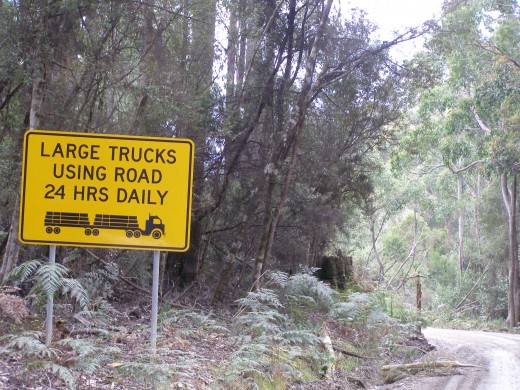 Styx Valley
Tasmania’s remaining wild forests..disappearing by Styx Valley
Tasmania’s remaining wild forests..disappearing by
…LARGE TRUCKS USING ROAD 24 HRS DAILY
.
.
Legal Sequel: ‘Opera House abseilers fined $200’
.
[Source: Sydney Morning Herald, 20111109, ^http://www.smh.com.au/environment/conservation/opera-house-abseilers-fined-200-20111109-1n6vv.html]
.
‘Three activists who scaled the Opera House, unfurling a banner bagging a retail giant, have been fined in a Sydney court. Miranda Gibson, 30, and Roseanne Phillips, 22, scaled the landmark on October 8 and abseiled from the western side of its western sail.
They unfurled a 10 by 12-metre yellow banner stating:
“No Harvey No! Stop selling Aussie forest destruction”
.
Scott Mackenzie, 37, also climbed to the top of the building carrying the banner on his back, but remained on the peak. They each pleaded guilty, in Downing Centre Local Court today, to a count of trespassing. Magistrate Janet Wahlquist fined them $200 each, plus court costs.
.
Outside court, Gibson, from the protest group The Last Stand, said the protesters had achieved their goal.
“We took action to bring the plight of our great and iconic native forests to another great Australian icon in the heart of Sydney, and to send a clear message to Harvey Norman that profiting from Aussie forest destruction is no way to do business in this day and age,”
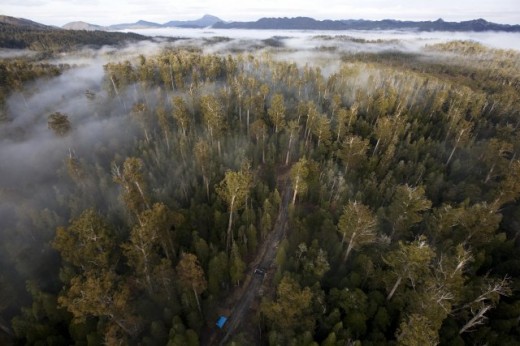
.
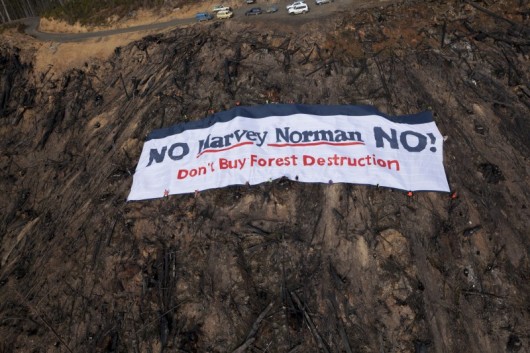 . .
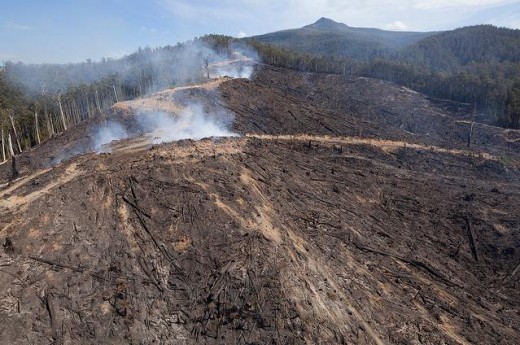 . .
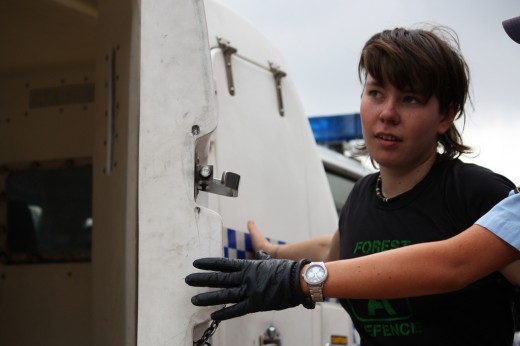 Fined $200 in NSW to dare to protest against destruction of Tasmania’s ancient native forests Fined $200 in NSW to dare to protest against destruction of Tasmania’s ancient native forests
.
.
The Last Stand has singled out Harvey Norman after a year-long investigation into its timber usage which, the protesters say, was contributing to the destruction of native forests.
They claim to have tracked timber from native forests in Australia through its shipment to China for processing into furniture, and then to its final sale in Australia through Harvey Norman stores.The store has previously said it was being unfairly targeted and did its best to source timber from sustainable sources.’
.
When will Gerry Harvey come clean on his personal profiting from native forests?
GO…search your morals Gerry Harvey!
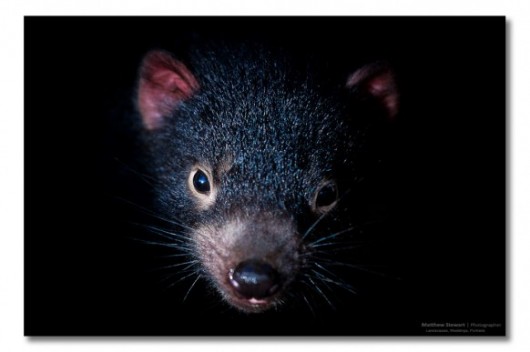 Tasmanian Devil
(Photo by Matthew Stewart, Flickr). Tasmanian Devil
(Photo by Matthew Stewart, Flickr).
.
Tags: a desperate cry, EKO Wood, forest network, Forestry Holocaust, Forestry Tasmania, Gerry Harvey, Go Harvey Norman, Go search your morals Gerry Harvey, Harvey Norman, Harvey Norman Flooring, Naturally Australian, No Harvey No, Still Wild Still Threatened, Stop selling Aussie forest destruction, Styx Valley, Sydney Opera House, The Last Stand
Posted in Tasmania (AU), Threats from Deforestation, Threats to Wild Tasmania | No Comments »
Add this post to Del.icio.us - Digg
Sunday, October 9th, 2011
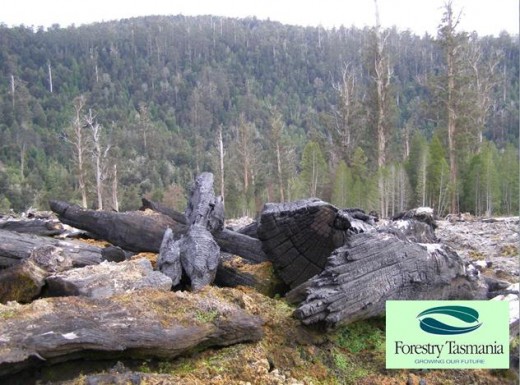 Forestry Tasmania – holocaust in Tasmania’s legendary Styx Valley
(Photo by editor, 20110928)
Forestry Tasmania – holocaust in Tasmania’s legendary Styx Valley
(Photo by editor, 20110928)
.
Selling Out Tasmania
First they came for the ancient Huon Pine and they exploited it —
The people accepted it because there seemed so much of it.
.
Then they came for the ancient Celery Top Pine, and they exploited it —
The people accepted it because there seemed so much of it.
.
Then they came for the ancient Eucalyptus regnans, and they exploited it —
The people accepted it because there seemed so much of it.
Then they came for the rest of Tasmania’s ancient forests —
until the ruling generation accepted it.. because they had never seen an ancient forest.
.
Previously, they had shot, poisoned and trapped Tasmania’s Thylacene —
because they imagined it killed their livestock —
The people accepted it because there seemed so many of them.
But they were all wrong,
as exploiters of the wild have inherently always been wrong.
Then the Thylacene was suddenly gone forever.
.
Since the timber getting has gone commercial, mechanical, industrial,
Tasmania’s once proud timbercraft tradition is vanishing with the forest.
.
When Tasmanians sell out to foreign dictators,
we betray Tasmania
When Australians become beholden to foreign dictators,
we betray our forefathers.
We are selling out Tasmania.
.
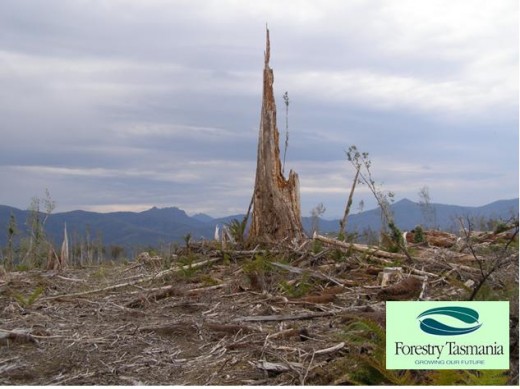 Forestry Tasmania – ‘growing whose future’?
(Photo by editor, 20110928)
Forestry Tasmania – ‘growing whose future’?
(Photo by editor, 20110928)
.
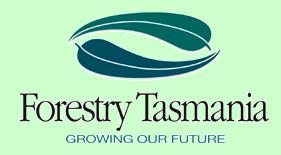 . .
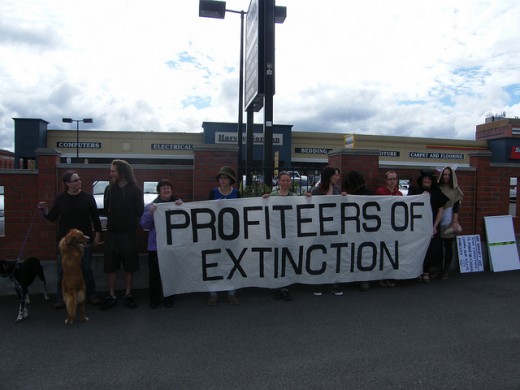 if the shoe fits… if the shoe fits…
.
[with apologies and respect to Martin Niemöller, who’s famous quotation about the Nazi Holocaust is apt in the current context of Forestry Tasmania’s extermination of Tasmania’s ancient forests.]
Tags: Celery Top Pine, Eucalytus globulus, forestry eugenics, Forestry Holocaust, Forestry Tasmania, growing our future, Huon Pine, Selling Out Tasmania, Styx Valley, Tasmanian holocaust, thylacene, Thylacene Bigotry
Posted in Tasmania (AU), Threats from Deforestation, Threats to Wild Tasmania | No Comments »
Add this post to Del.icio.us - Digg
Saturday, October 8th, 2011
Tasmania’s ancient Eucalyptus regnans of the Upper Florentine, South-West Tasmania…chainsawed in utter spite by Forestry Tasmania in its infamous forest raid on Tuesday 13th January 2009.
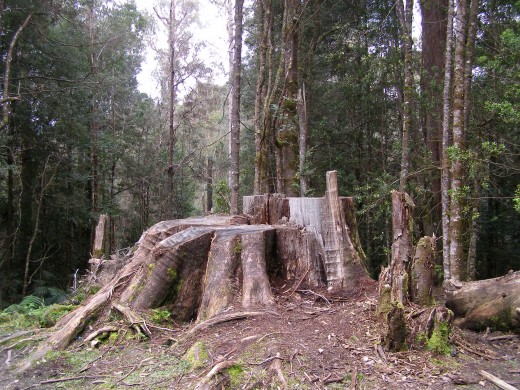 (Photo at Camp Flozza, Upper Florentine, South-West Tasmania, by editor 20110928,
Photo free as always in public domain – click to enlarge, then click to enlarge again)
(Photo at Camp Flozza, Upper Florentine, South-West Tasmania, by editor 20110928,
Photo free as always in public domain – click to enlarge, then click to enlarge again)
.
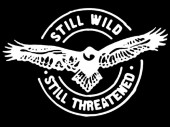 ^www.stillwildstillthreatened.org
^www.stillwildstillthreatened.org
.
‘There are people at Forestry who obviously don’t see green,
they see red..
The bunker mentality surfaces,
the big boots go in,
the chainsaws are fired up.
and ‘Common Sense’…goes out the window.’
[Source: Editorial, The Mercury, 20070219]
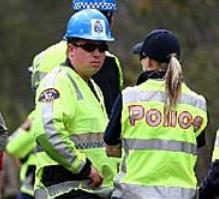
.
.
The 2009 Bartlett-Gordon Old Growth Massacre
 Then Tasmanian Premier David Bartlett Then Tasmanian Premier David Bartlett
.
 Then Forestry Tasmania Managing Director Bob Gordon Then Forestry Tasmania Managing Director Bob Gordon
.
13 January 2009: ‘Camp Floz Busted…Camp Flozza was raided by 60 cops this morning. They are back in force to ensure logging starts in the pristine Upper Florentine. They are held off by 3 conservationists in 50m high tree sits, 2 in cars locked to the road, and one in a tunnel.’
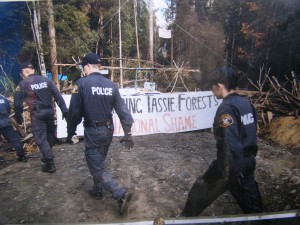 . .
‘Push came to shove in the Upper Florentine Valley yesterday. Scuffles broke out as about 200 protesters confronted a line of police blocking access to a contested logging road. Police arrested 15 people during yesterday’s Community Walk-In For the Florentine march.
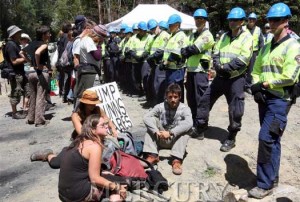
…Most of the old-growth forest to be cut in the area will become woodchips.
The two-year-old protest camp was destroyed on Tuesday although four protesters continued a vigil on two treetop platforms. They could be heard shouting their defiance throughout yesterday’s protest.
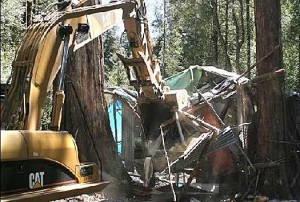
“It makes a mockery of the clever and kind Bartlett rhetoric when carbon-rich old-growth forests in an intact valley of World Heritage value are being opened up with a brand new logging road for clearfelling.” ~ Wilderness Society spokesman Vica Bayley.

Late yesterday, Derwent district forest manager Steve Whiteley said contractors had resumed work. “Our staff and contractors are cleaning up the site of Camp Florentine and undertaking road repair and construction,” he said. “We have had plans in place for several years to harvest a 50ha coupe and to build four kilometres of road.’

[Source: Arrests at Camp Flozza’, by David Killick, 20090114, ^http://www.themercury.com.au/article/2009/01/14/49611_tasmania-news.html]
.
.
‘Eyes that see much, and have so much seen’
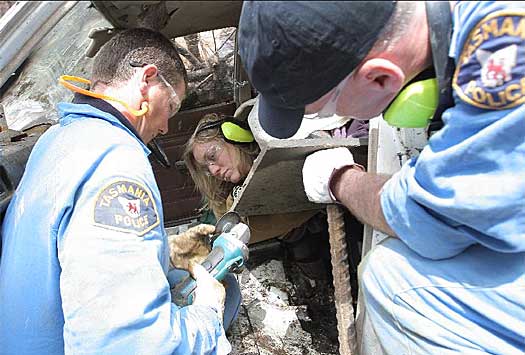 Taking a last stand to save Tasmania’s ancient forests
January 2009 police raid Camp Flozza, the front line defence of the Upper Florentine Forests Taking a last stand to save Tasmania’s ancient forests
January 2009 police raid Camp Flozza, the front line defence of the Upper Florentine Forests
.
 “Here’s to the crazy ones, the misfits, the rebels, the troublemakers, the round pegs in the square holes “Here’s to the crazy ones, the misfits, the rebels, the troublemakers, the round pegs in the square holes
… the ones who see things differently — they’re not fond of rules… You can quote them, disagree with them, glorify or vilify them, but the only thing you can’t do is ignore them because they change things… they push the human race forward,
and while some may see them as the crazy ones, we see genius,
because the ones who are crazy enough to think that they can change the world, are the ones who do.”
~ Steve Jobs (1995-2011)
.
.
O Brave.. ‘New Tasmania?’
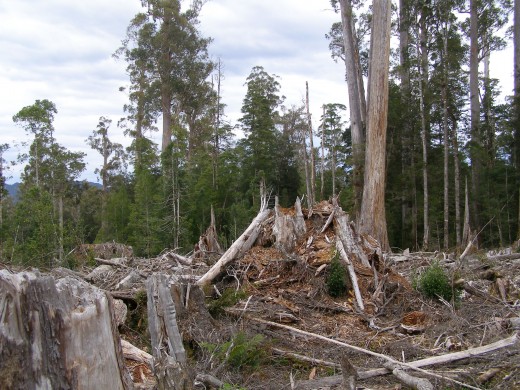
Upper Florentine under current industrial attack from Forestry Tasmania
(Photo at Camp Flozza by editor 20110928, free in public domain – click to enlarge, then click to enlarge again)
.
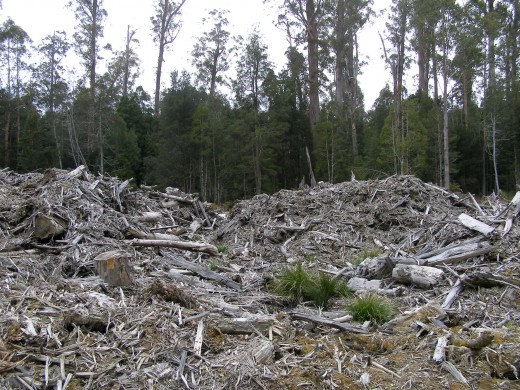 …those who come raiding at dawn.
(Photo at Camp Flozza by editor 20110928, free in public domain – click to enlarge, then click to enlarge again) …those who come raiding at dawn.
(Photo at Camp Flozza by editor 20110928, free in public domain – click to enlarge, then click to enlarge again)
.
‘The struggle for the soul of the island has raged for 200 years.
And it rages still, and still governments divide us against ourselves.
Resistance now is the staunch child of resistance past.
And it bodes for the future.’
~ Pete Hay
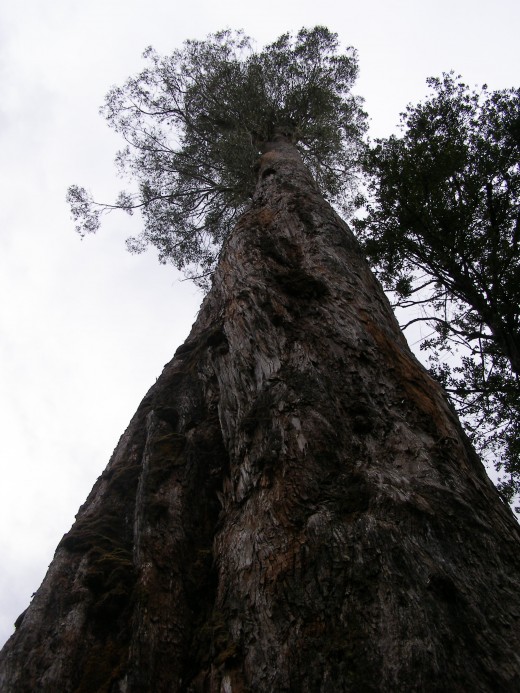 (Photo at Camp Flozza by editor 20110928, free in public domain – click to enlarge, then click to enlarge again)
(Photo at Camp Flozza by editor 20110928, free in public domain – click to enlarge, then click to enlarge again)
.
‘What must I do to protect you – he yells the trees…’
~ Barney Roberts
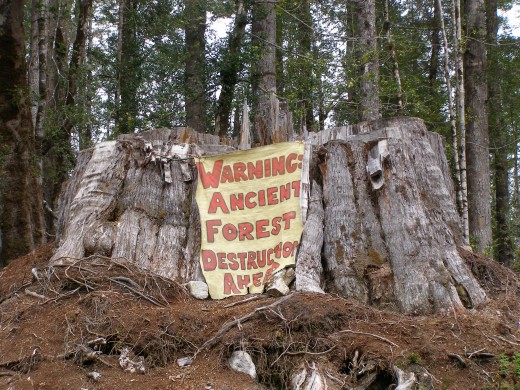 (Photo at Camp Flozza by editor 20110928, free in public domain – click to enlarge, then click to enlarge again) (Photo at Camp Flozza by editor 20110928, free in public domain – click to enlarge, then click to enlarge again)
.
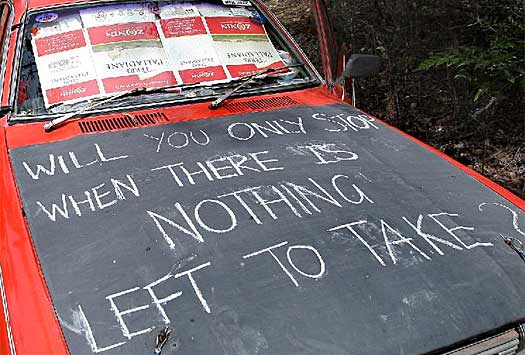 (Photo at Camp Flozza January 2009 by Sam Rosewarne, The Mercury newspaper)
(Photo at Camp Flozza January 2009 by Sam Rosewarne, The Mercury newspaper)
.
‘Documentary photography offers the future a view of the past.
It bears witness in an age when publications turn toward entertainment, celebrity and spin.
This is the history of Tasmania.
It should be documented.’
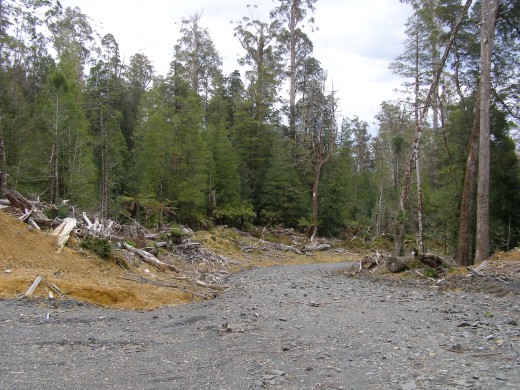 Foresty Tasmania ~ they came with 60 police,
they bulldozed their road through pristine old growth forest
(Photo at Camp Flozza by editor 20110928, free in public domain – click to enlarge, then click to enlarge again) Foresty Tasmania ~ they came with 60 police,
they bulldozed their road through pristine old growth forest
(Photo at Camp Flozza by editor 20110928, free in public domain – click to enlarge, then click to enlarge again)
.
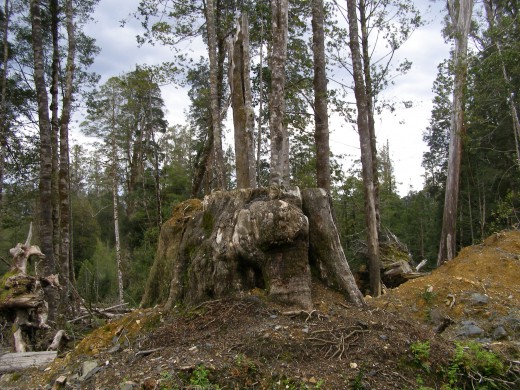 Forestry Spite
(Photo at Camp Flozza by editor 20110928, free in public domain – click to enlarge, then click to enlarge again) Forestry Spite
(Photo at Camp Flozza by editor 20110928, free in public domain – click to enlarge, then click to enlarge again)
.
[Quotes from Matt Newton & Pete Hay’s 2007 important photographic book , ‘The Forests’, ^http://www.matthewnewton.com.au/#/Documentary/The%20Forests/1]
.
.
Tags: 2009 Bartlett-Gordon Massacre, Bob Gordon, Camp Flozza, Chinese Imperial Dictatorship, David Bartlett, Eucalyptus regnans, forest exploitation, forestry spite, Forestry Tasmania, greedy commercial gain, Martin Niemöller, South-West Tasmania, Steve Jobs, Still Wild Still Threatened, Tasmania's holocaust, Tasmania's Thylacene, Tasmanian ancient forests, Upper Florentine Forest, utter spite
Posted in Tasmania (AU), Threats from Deforestation, Threats to Wild Tasmania | No Comments »
Add this post to Del.icio.us - Digg
Wednesday, October 5th, 2011
Every year after summer and upon the onset of winter, the outdoor pool at Katoomba Sports and Aquatic Centre, situated in Central Blue Mountains, is drained. Its contents including the chlorine (likely sodium hypochlorite) is emptied. The adjacent old plumbing between the pool and the dam, as well as repeated conductivity tests by the editor over multiple years under the Sydney Catchment Authority Streamwatch Programme point to the drainage being into the adjacent dam and into the Kedumba River; not into the sewer..
Reports of extreme water conductivity (off the scale… 500+ micro Siemens/cm) in the dam immediately following the draining the pool scale were sent to the Sydney Catchment Authority (SCA) , but nothing was ever done about it by the SCA.
This means every year, thousands of litres of chlorinated pool water flushes over Katoomba Falls and along the Kedumba River through the Greater Blue Mountains World Heritage Area.
It is therefore no surprise then that the Kedumba River looks clean – Blue Mountains Council ensures it is sterile of macro-invertebrates and river life.
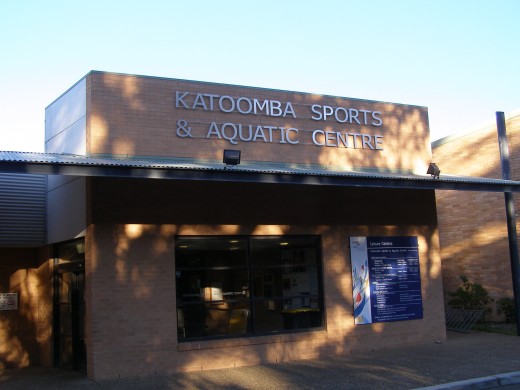 Katoomba Sports & Aquatic Centre
Blue Mountains, New South Wales, Australia Katoomba Sports & Aquatic Centre
Blue Mountains, New South Wales, Australia
.
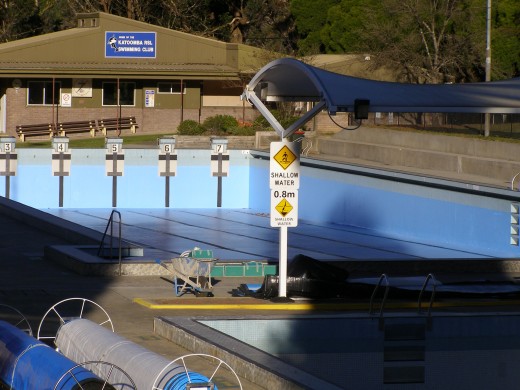 The Outdoor Pool of the Aquatic Centre…drained every winter
(Photo by Editor 20110516, free in public domain) The Outdoor Pool of the Aquatic Centre…drained every winter
(Photo by Editor 20110516, free in public domain)
.
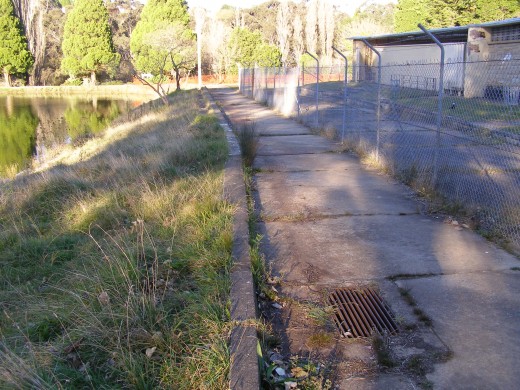 The Aquatic Centre was constructed conveniently adjacent to the Catalina Dam The Aquatic Centre was constructed conveniently adjacent to the Catalina Dam
.
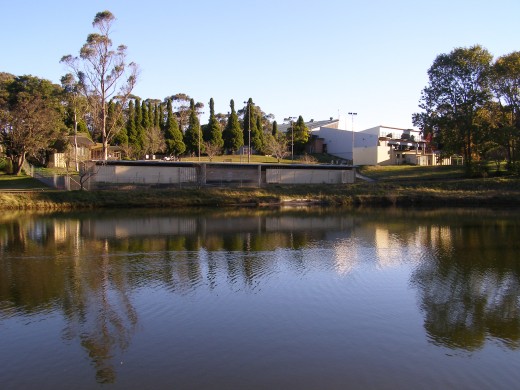 Catalina Dam, which in the late 1940s was glorified as a ‘lake’ by developer Horace Gates
Catalina Dam, which in the late 1940s was glorified as a ‘lake’ by developer Horace Gates
(designed with a flotation levelling system interconnected to adjacent Katoomba Falls Creek)
.
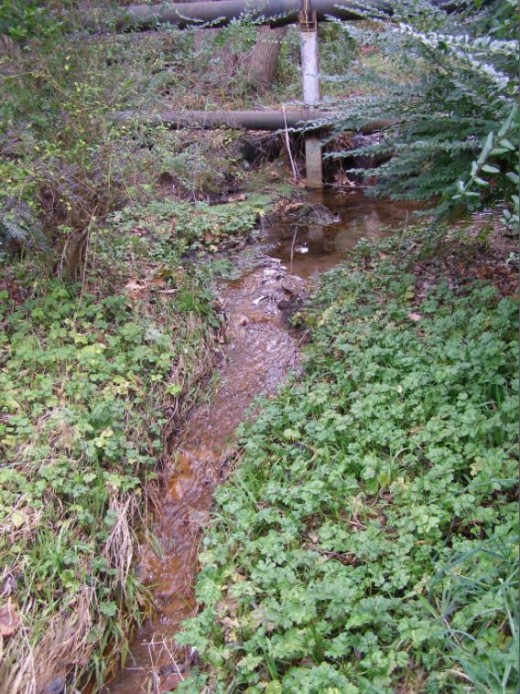 Upper Kedumba Creek downstream of Catalina Dam Upper Kedumba Creek downstream of Catalina Dam
.
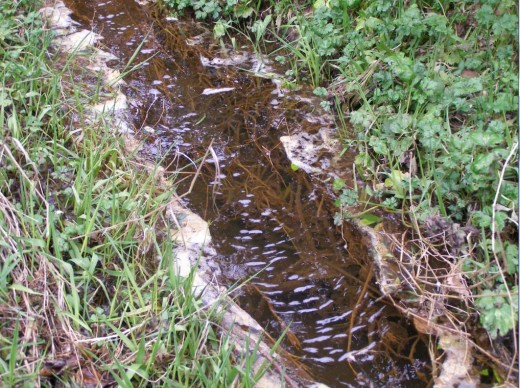 Upper Kedumba Creek downstream of Catalina Dam – close up Upper Kedumba Creek downstream of Catalina Dam – close up
.
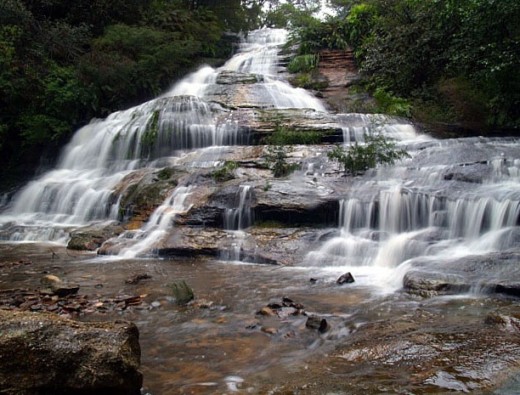 Katoomba Falls Creek naturally flows over Katoomba Falls Katoomba Falls Creek naturally flows over Katoomba Falls
.
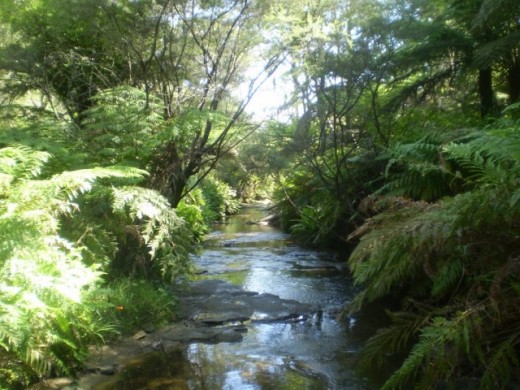 Katoomba Falls flows down the Blue Mountains escarpment into the Kedumba River Katoomba Falls flows down the Blue Mountains escarpment into the Kedumba River
.
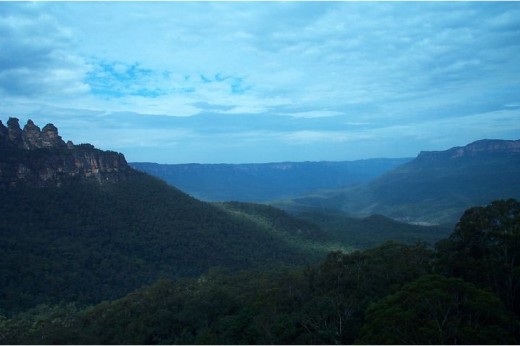 The Kedumba River flows through the Greater Blue Mountains World Heritage Area. The Kedumba River flows through the Greater Blue Mountains World Heritage Area.
Tuesday, October 4th, 2011
The spin from the dying legacy that is Forestry Tasmania, Tasmanian taxpayer subsidised yet still proudly loss making, is palpable.
In 2009, it enticed a travelling UK backpacker, ‘Shannon’, to include its propaganda on her blog ~ silly naive girl.
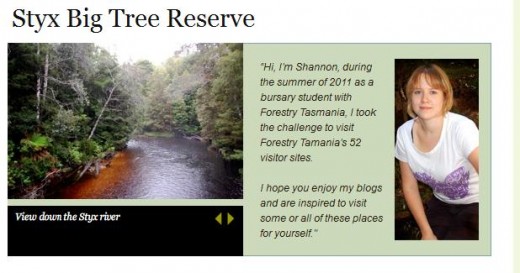
Check the spiel..which Forestry added to its website:
^http://www.forestrytas.com.au/visiting/visitor-sites/central/styx-big-tree-reserve
The Forestry Propaganda continues as follows, but we consider it appropriate to intersperse the spiel with photos of Forestry Truth in the Styx Forests nearby inflicted by Forestry Tasmania and continuing to happen right now in October 2011!
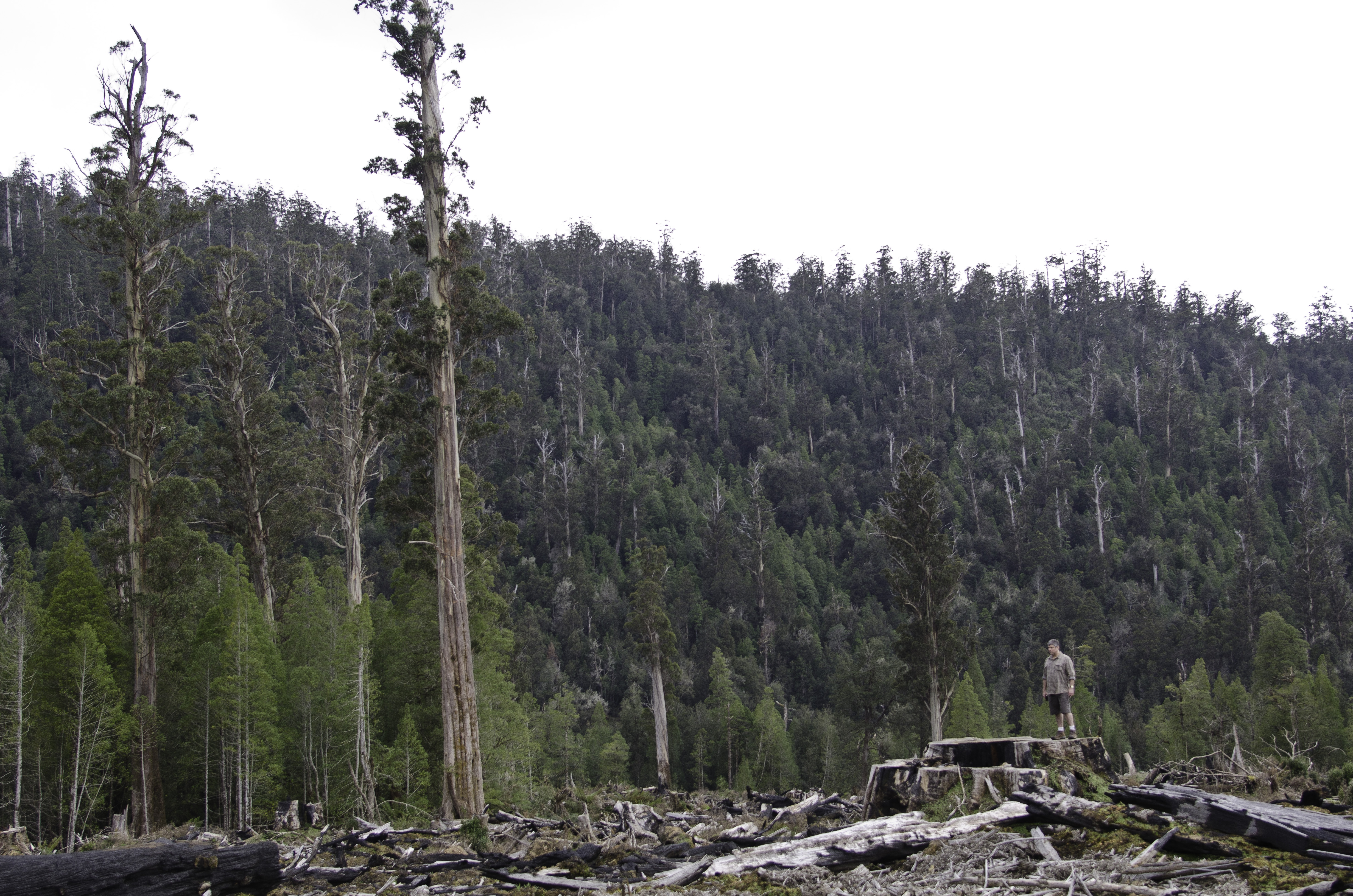 Styx Big Trees decimated around the corner by Forestry Tasmania Styx Big Trees decimated around the corner by Forestry Tasmania
(Photo by Alan Lesheim Photography, 20110928)
.
‘Standing in the pouring rain in the middle of the one of Tasmania’s state forests, is not something I would usually consider fun (the things I do to keep you guys informed). However, on this particular day it wasn’t as bad as it sounds. Where am I…? I hear you ask.
About an hour and 15 minutes north-west of Hobart, is a little town called Maydena, and just a short drive past the town, is the Styx Big Tree Reserve. Well, now you know where I am, let me tell you about the day I spent up there.
I headed up through New Norfolk, along the Lyell Highway, through some charming, little country towns like Glenora and Westerway. Along this road, Maydena is the last point of service, and so I called into Maydena Adventure Hub (Forestry Tasmania’s latest tourism venture) to refuel both the car, and myself. The coffee is lovely, and they have a range of foods, such as toasted sandwiches, salad rolls, and the like. From here, I headed about ten minutes further along the road, to a turn-off which leads you into the heart of the forest, and to the Styx Big Tree Reserve.
The road is gravel; however it had been recently graded so it is suitable to all car types. If you keep your eye out, the signs located along the road will point you in the right direction, and it’s about 15km to the actual reserve. After the initial turn-off there is only one other turn-off and then you basically just following the one road the rest of the way. You can tell you are getting closer if you notice the trees are getting bigger.

(Photo of Styx Forest by Alan Lesheim Photography – click photo to enlarge)
.
The reserve is equipped with toilets, disabled access and a car park. It also has some lovely picnic facilities throughout the forest. Due to my unorganised nature, and the fact that the decision to come up here was very spontaneous, I was not well equipped to deal with the wet weather, or the forest. Luckily, someone in the office leant me their waterproof jacket, and with my jeans tucked into my socks to keep away the leeches (paranoid I know), I told myself to toughen up and get out there!
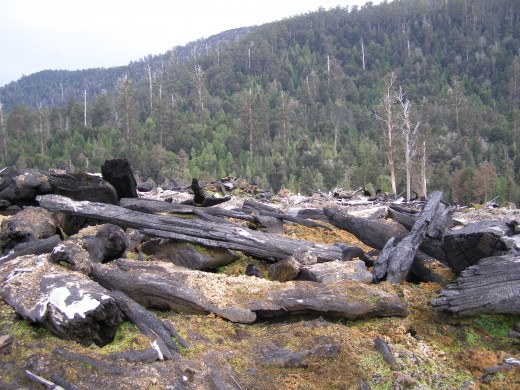
Styx Big Trees incinerated in a irreversible holocaust fire by Forestry Tasmania…”a lack of regular wildfires”…we’ll fix that!
(Photo by Editor 20110928, free in public domain)
.
The Big Tree Reserve has a boardwalk, which takes you on an informative tour of the giants that call this forest home. It turns out that the trees here can grow so big due to a combination of factors including, high rainfall (1000-1500mm per year), high soil nutrient content, and a lack of regular wildfires in this particular area. The trees in this area are over 85m tall, and are swamp gums.
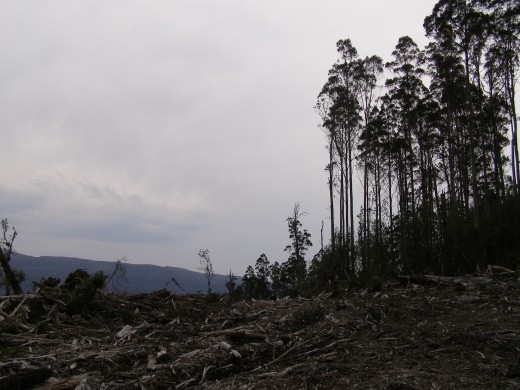 The Styx – what is and what was
(Photo by Editor 20110928, free in public domain) The Styx – what is and what was
(Photo by Editor 20110928, free in public domain)
.
There is so much to learn here, and I won’t tell you anymore, you will just have to come up and experience it yourself! Or, if you like, Maydena Adventure Hub can set you up a guided tour of the Styx Forest, or other areas in the region. The staff in there are very approachable and will be happy to help you out with anything you need to know.
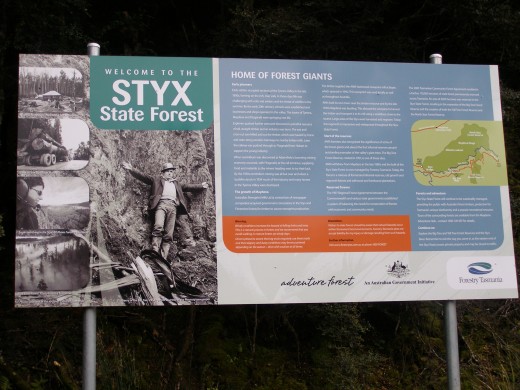
Forestry Tasmania’s infamous tourist ‘Welcome’ sign…welcome to our ‘Styx Holocaust’
(Photo by Editor 20110928, free in public domain)
Rain or no rain, it was a lovely experience. Heading back from the reserve you can either turn right and continue further west to Lake Pedder and Strathgordon, or turn left and explore the rest of what Maydena has to offer. As I left it so late to leave from Hobart that morning, and the wet weather, I thought it would be best just to head back home. However, don’t worry, I will be back shortly and then I will let you know what the rest of the South-West wilderness has to offer.
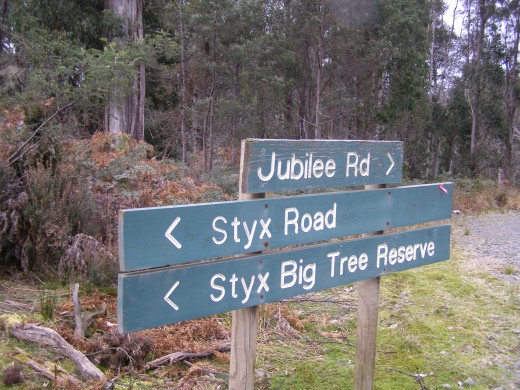
Gullible tourists directed left, while Big Tree ecocide lies in a battle field right nearby.
(Photo by Editor 20110928, free in public domain)
.
Until next time, get out there and explore some of these wonderful sites for yourself. Oh and by the way, someone was just trying to scare me and I didn’t even come across any leeches!’
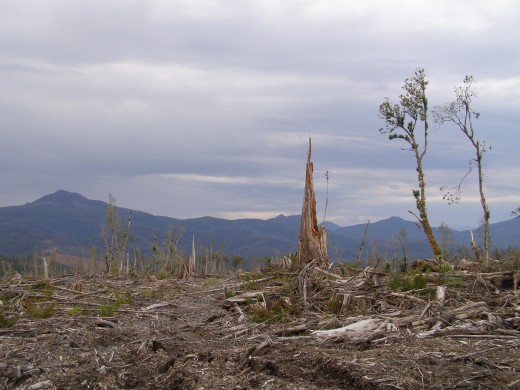 Styx Forest after Forestry Tasmania has been through
(Photo by Editor 20110928, free in public domain) Styx Forest after Forestry Tasmania has been through
(Photo by Editor 20110928, free in public domain)
.
GPS Coordinates :
LAT : 42°48’54.79″S
LON : 146°39’51.46″E
Monday, October 3rd, 2011
|
|
 Stihl Concrete Saw
Stihl Concrete Saw
 Stihl Saw Nutter – contracted with Forestry Tasmania, October 2008
Stihl Saw Nutter – contracted with Forestry Tasmania, October 2008 Stihl President – Fred Whyte
(Billings Gazette)
Stihl President – Fred Whyte
(Billings Gazette)











































































 Styx Big Trees decimated around the corner by Forestry Tasmania
Styx Big Trees decimated around the corner by Forestry Tasmania





